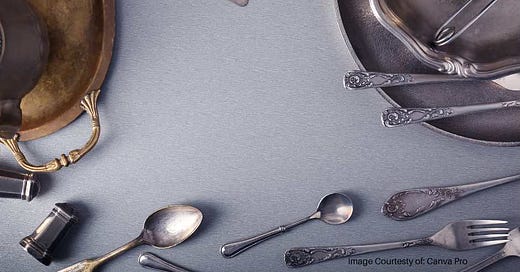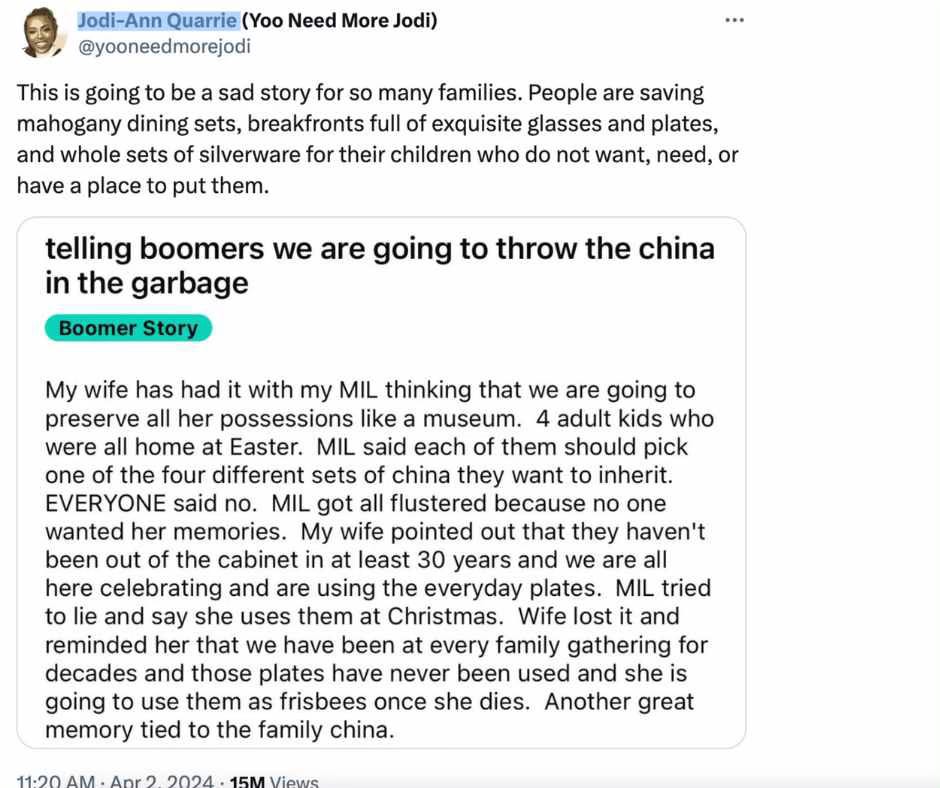Keeper of Things or Preserving History?
You'd better take another look before you toss out your mom's heirlooms
Were you gifted a family heirloom for Mother’s Day this year? Perhaps your great grandmother’s crystal, the legacy silverware, or a favorite piece of your mother’s china, or maybe even the entire collection?
This week Shangrilogs Cabin Notes shared a recent tweet and asked for unsolicited opinions on Boomer downsizing, what do you do with the china?
With the Industrial Revolution and the rise of factories came the ability to make many pieces of silverware, quickly and uniformly. Add to this the discovery of vast amounts of silver from the Comstock Silver Mine beginning in 1859, which made silver much more affordable and available, and the great silver services of the Victorian era and Gilded Age were an inevitable outcome.—M.S. Rau
Keeper of things
When my mother moved into assisted living it was our job (my brother’s and mine) to pack up the apartment and move everything into storage. We rented two large10'x20' climate controlled units paying $102 a month for two years before going back to go through and clear out the units.
It was easy to get rid of her living room and bedroom furniture. I kept the formal dining room furniture and the rest was given away. My brother wanted none of it.
All that was left were boxes of knick-knacks, glassware, china, crystal, and photos. Forty-four medium boxes (18 x 18 x 15 inches and 22 x 16 x 15 inches or 3 cubic feet) of photos to be exact. The photos dated back to 1873. The crystal dated 1942, the china circa 1940s, and the Royal Danish flatware dated 1939.
My mother also saved her dedicated scrapbooks of WWII, original newspaper clippings, and various valuable schematics of war planes. My dad saved everything he and his family deemed valuable during his time spent overseas as a P-47 Thunderbolt pilot.
That was just the beginning.
In addition to their own collections, my parents also inherited everything from their parents and grandparents. It was overwhelming but fascinating going through the history.
My mother and father were packrats, their own description of themselves, every time we moved.
Going through the dinnerware boxes was not interesting; it was hard work.
Preserving history
I currently work for a historic site that features two Queen Anne-style restored homes belonging to the area’s wealthiest lumber barons, offering visitors a glimpse into life during the Victorian Era. One interesting aspect of understanding this era is the significance of fine dining, where crystal, china, and silver flatware played essential roles.
During a recent tour, one of our guests took note of the displayed dinnerware and inquired whether it was an artifact or a period piece curated for storytelling purposes. Knowing a little of the backstory, I shared that Erie, the family’s adopted daughter, had either donated or gotten rid of nearly all belongings from the original household upon inheriting the home in 1905.
The guest was visibly appalled and began asking more questions, fueling an ongoing discussion about family heirlooms and how many people in today’s world aren’t interested in keeping them. This conversation dominated the entire hour-long tour.
Erie married Leigh in 1888 at the age of 22. The wedding present was $1,000 and the deed to her parents' first home, fully furnished. While it isn’t documented, I imagine she was also gifted crystal, china, and silver flatware of her own. After her parents died, she inherited the second family home (the one I currently guide in), where she lived for six years before renting it out. Eventually, she moved to California, and the property remained rented until her death in 1943 at the age of 77.
It’s interesting to note that Erie never spoke to her parents after marrying Leigh, so she was rather surprised she inherited anything at all. Does this explain why she wasn’t sentimentally attached to the family heirlooms?
However, it remains that even in 1905, there was someone (a rather wealthy someone) who had no interest in preserving a family history.
(Back) to the family heirlooms
I don’t know much about my mother’s past, just bits and pieces. She was born in 1922 and had three brothers and two sisters. My grandmother had a bar, ran a small hotel, and owned a beauty shop during the Depression. My grandfather was a pattern maker for Dow Chemical and attended law school at night. They didn’t spend much time around their kids. They had a live-in housekeeper who kept things in order. From what little she shared, my mother, second from the oldest, didn’t fit in. My grandfather liked making kids, but he didn’t like raising them.
As each daughter reached marrying age, they received a portion of my grandmother’s collection as engagement and wedding gifts: crystal glassware, place settings for four of china, and silver flatware.
My mother added onto her collections, so by the time they were passed on to me, she had 54 place settings of china, seven types of crystal stemware service for 16, and two Royal Danish 66 -Piece silver flatware sets, dinner size, with cream soup spoon, providing service for 48.
What was I supposed to do with all of this?
I certainly wasn’t preserving history. I wasn’t married at the time and never had children. My brother and I were the last of our family.
Plus, I was constantly moving, opening new casinos around the country as gambling proliferated.
So, I did what any all-American terrible daughter would do: I sold, donated, or gifted everything away, just like Erie did 105 years prior.
I donated the china to a historical museum in Florida, and they were thrilled to accept it. I gifted the crystal stemware to my (then) best friend to display in her own curio cabinet. However, we no longer speak and haven’t had contact in a number of years.
As for the flatware, I held onto it until it became a bother to keep it safe and secure, especially as the silver market price was peaking. What I didn’t know is that you can’t sell silver flatware for the spot silver price unless you are dealing with someone who is an expert in precious metals.
The estate jewelry appraiser didn’t share this, and quite honestly, I didn’t ask. He simply "weighed it" and came back with a price. The appraiser also failed to mention that the pattern I brought in was rare and valuable. He wrote out a $500 check for each box. At that time, silver was going for $20.14 a troy ounce.

Don't it always seem to go
That you don't know what you got 'til it's gone?— Joni Mitchell, Big Yellow Taxi
What is the formula for calculating silver price?
“The formula is: rate of silver per gram x weight of silver x purity of silver. She explains this with an example. Suppose you plan to buy a silver anklet that weighs 36.040 grams. The jeweler quotes the price of silver as Rs 65 per gram or Rs 65,000 per kg.
Measuring silver’s value can be a bit tricky, which is why we recommend consulting with an expert so that you can receive a proper valuation of the fine metals and gems you possess.”—Gold Fellow
Antiques Reseller says:
“I actually do sell most of my silver and gold to pawn shops or Cash For Gold joints, as they typically pay spot price (that day's going rate for the respective precious metal). I only use those resources when I'm selling SCRAP silver and gold. i.e., ruined silverware, broken jewelry, pieces, parts. Before going into the store, look up what the spot price is (I'm assuming we're talking sterling silver, so that'd be around $16 an ounce) that way you're informed. If they refuse to offer you any better than 15% less of the spot price, walk away. You can get a better deal elsewhere. Most shops I've worked with have offered me within 5% of that day's spot price, and even exactly the price before.
Assuming your silverware is actual silver and NOT silverplate, you could sell it to an antiques store (provided, they won't pay you what it's worth, because they need to make a buck, but you will likely get more than a pawn shop) or you can sell it online through Craigslist, Facebook Marketplace, eBay, or any of the numerous selling apps out there. Do your research (maker, pattern, metal %) and figure out the going rate, and price it around there.”
How much is the Royal Danish Flatware worth today?
Actually, today it is going for less than it was when I sold it. Remember, this is X’s 2.
Millennials and Gen Z weigh in on the matter
“I think some are worth holding onto, like if you specifically knew the person who had it or you grew up hearing stories about a specific item. Other than that if it isn't something that I would wear or use I would probably try and sell it or regift it to someone who could use it.” -Val, 26
“Sure, I love holding onto family heirlooms! Like my mom got some of her grandmother’s furniture and my sister and brother don’t care for it but I’m hoping to get it one day! It’s like a bedroom set, a buffet table, cabinets and what not. As for silver, crystal, and china, maybe if I would use it for special occasions or if it held sentimental value. Jewelry, probably not just cause I’m not much of a jewelry wearer unless it was a super pretty ring.” -Lisa, 30
“If I had any family heirlooms I would hold onto them.” -Tess, 22
So, are you a keeper of things or preserving history?









I kept some things and parted with others. A move to Florida required that I let go of a lot of my own belongings. When I moved back (and after my Mom's death) we had to go through her stuff. With regard to that, I only kept things that held a specific emotional attachment.
My feeling today is if it's sitting in a box in storage I don't need it. Downsizing and minimalism feels freeing somehow.
Interesting post! I owned a "senior downsizing" business for about five years and dealt with this issue each week as I helped sort out what to Keep, Sell, Give Away and trash. Ninety five percent of the time, the family had ZERO interest in keeping anything. Sometimes we'd get the pieces donated to an appropriate home, much like you did. For run-of-the-mill china and silver sets, they'd often go to auction. Other times, for small estates, the items would be donated. Over the years I cultivated a relationship with a local candle maker... she'd take the pretty teacups & saucers (for $0), fill them with wax and make candles out of them. She sold them for $10 each in a local gift shop. They sold very well!